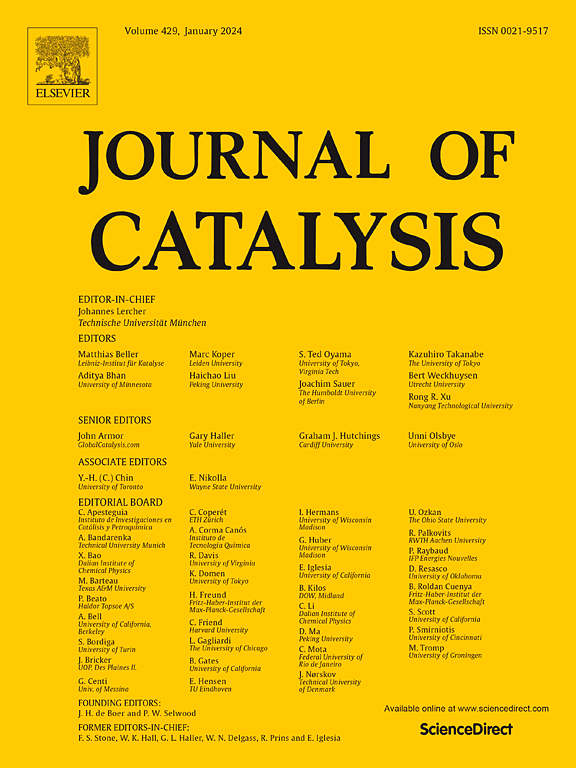TBD-grafted activated carbon as an efficient solid base catalyst for continuous Knoevenagel reaction
IF 6.5
1区 化学
Q2 CHEMISTRY, PHYSICAL
引用次数: 0
Abstract
The development of a highly efficient and stable metal-free solid base catalyst for the Knoevenagel reaction remains a significant challenge. In this study, activated carbon is selected as support material to develop a new base catalyst due to its excellent chemical stability. A novel surface chloromethylation method is applied to modify the activated carbon surface, followed by covalent grafting of 1,5,7-triazabicyclo[4.4.0]dec-5-ene (TBD), resulting in a highly effective solid organic base catalyst. A continuous platform based on a micro-packed bed reactor has been optimized for the Knoevenagel reaction. The system achieves excellent space-time yields (19129.4 ) and demonstrates a broad substrate scope. The solid organic base catalyst exhibits a turnover frequency (TOF) exceeding 140 , surpassing the performance of similar nitrogen-based catalysts reported in literature (7.6–68.0 ). Moreover, the catalyst shows no signs of deactivation after more than 23 h of continuous operation with a turnover number (TON) exceeding 115, indicating comparable performance reported in literature (29.7–297.2). Catalyst deactivation is primarily attributed to the adsorption of raw materials and products onto the base sites, leading to a gradual loss of catalytic activity.


TBD 接枝活性炭作为连续 Knoevenagel 反应的高效固体基催化剂
为克诺文纳格尔反应开发高效稳定的无金属固体基础催化剂仍然是一项重大挑战。在本研究中,活性炭因其优异的化学稳定性而被选为开发新基催化剂的支撑材料。研究采用一种新型表面氯甲基化方法对活性炭表面进行改性,然后共价接枝 1,5,7-三氮杂双环[4.4.0]癸-5-烯 (TBD),最终得到一种高效的固体有机基催化剂。针对克诺文纳格尔反应,我们优化了一个基于微型堆积床反应器的连续平台。该系统实现了出色的时空产率(19129.4 gProkgcat-1h-1gProkgcat-1h-1),并展示了广泛的底物范围。固体有机基催化剂的周转频率(TOF)超过 140 h-1h-1,超过了文献报道的类似氮基催化剂的性能(7.6-68.0 h-1h-1)。此外,该催化剂在连续运行超过 23 小时后没有出现失活迹象,其周转次数(TON)超过 115,表明其性能与文献报道(29.7-297.2)相当。催化剂失活的主要原因是原料和产品吸附在基底位点上,导致催化活性逐渐丧失。
本文章由计算机程序翻译,如有差异,请以英文原文为准。
求助全文
约1分钟内获得全文
求助全文
来源期刊

Journal of Catalysis
工程技术-工程:化工
CiteScore
12.30
自引率
5.50%
发文量
447
审稿时长
31 days
期刊介绍:
The Journal of Catalysis publishes scholarly articles on both heterogeneous and homogeneous catalysis, covering a wide range of chemical transformations. These include various types of catalysis, such as those mediated by photons, plasmons, and electrons. The focus of the studies is to understand the relationship between catalytic function and the underlying chemical properties of surfaces and metal complexes.
The articles in the journal offer innovative concepts and explore the synthesis and kinetics of inorganic solids and homogeneous complexes. Furthermore, they discuss spectroscopic techniques for characterizing catalysts, investigate the interaction of probes and reacting species with catalysts, and employ theoretical methods.
The research presented in the journal should have direct relevance to the field of catalytic processes, addressing either fundamental aspects or applications of catalysis.
 求助内容:
求助内容: 应助结果提醒方式:
应助结果提醒方式:


